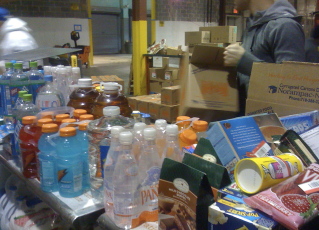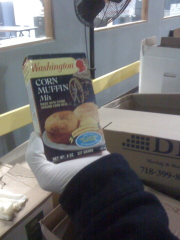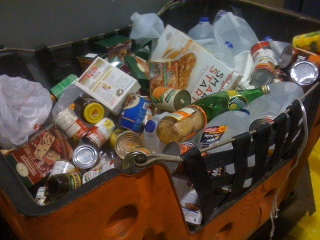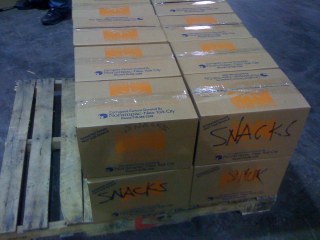Food rescue
Last weekend -- perhaps to offset the insane amount of food waste we generate at breakfast and lunch -- my office organized a volunteer opportunity with the Food Bank for New York City. Basically what the Food Bank does is take gigantic donations of food and re-distributes it to hunger programs in the five boroughs. They operate out of an industrial warehouse at the Hunt's Point market in the Bronx. I was super-excited because individuals can't volunteer on their own - they get referred to a partner soup kitchen, homeless shelter, school, etc. While these programs are vital, the Food Bank interests me in particular because of its emphasis on efficiency of resources and reduction of waste.
My coworkers and I were tasked with re-packaging food that had been donated through some of its smaller sources: can drives at schools and workplaces and, surprisingly, Target. If a box of cereal gets run over by a shopping cart or a curious kid damages the packaging of something, the product gets pulled from the shelf; most of the time, these perfectly useful and edible things go into the trash. This thoughtful Target (I don't know which one) dumps them all in boxes and sends them to the Food Bank. (They probably get a tax write-off, too.)
 We were sorting the items by category: fruits, vegetables, household products, personal care, beverages, snacks, etc., and creating boxes of a particular weight, determined by what was inside it. The Food Bank gave us detailed handouts about dented cans and expiration dates: some of the items had to be discarded after their expiration dates, others they have guidelines written by a nutritionist on how long past the date is acceptable to pass the donations along. The items that didn't pass our tests had to go in a big orange trash bin.
We were sorting the items by category: fruits, vegetables, household products, personal care, beverages, snacks, etc., and creating boxes of a particular weight, determined by what was inside it. The Food Bank gave us detailed handouts about dented cans and expiration dates: some of the items had to be discarded after their expiration dates, others they have guidelines written by a nutritionist on how long past the date is acceptable to pass the donations along. The items that didn't pass our tests had to go in a big orange trash bin.
The whole thing was incredibly eye-opening, for a number of reasons. I was astonished at how many things were donated that were way past their expiration dates - this box of muffin mix looks like an antique!  It's great that people open their cabinets during food drives, but I think they forget that actual people are supposed to end up with this stuff. I was also heartbroken every time something went into the trash: I would estimate that 10% of the stuff we sorted ended up in the bin. Maybe 1% of that amount I wouldn't have eaten, faced with the same dilemma at home. Now, I know that I've done some stuff this year that people would label gross by conventional standards - using hankies, not flushing every single time, collecting my food scraps in the fridge for compost. But this stuff was only marginally gross: boxes of things slightly past their expiration, stale cookies, juice with the label ripped off. It killed me to see it tossed - yes, that's water in the bin below (I think the bottle was too misshapen to pass along) - and I know that the Food Bank can't compromise its reputation for this lowly 10%. I asked one of the regular employees if any local homeless people had figured out that the Food Bank bins were full of food. He said he knew some people had been in them before, but they were kind of difficult to get to and it didn't happen very often. The market is geographically isolated, surrounded by gates, high fences, and barbed wire - I doubt too many scavengers make it in.
It's great that people open their cabinets during food drives, but I think they forget that actual people are supposed to end up with this stuff. I was also heartbroken every time something went into the trash: I would estimate that 10% of the stuff we sorted ended up in the bin. Maybe 1% of that amount I wouldn't have eaten, faced with the same dilemma at home. Now, I know that I've done some stuff this year that people would label gross by conventional standards - using hankies, not flushing every single time, collecting my food scraps in the fridge for compost. But this stuff was only marginally gross: boxes of things slightly past their expiration, stale cookies, juice with the label ripped off. It killed me to see it tossed - yes, that's water in the bin below (I think the bottle was too misshapen to pass along) - and I know that the Food Bank can't compromise its reputation for this lowly 10%. I asked one of the regular employees if any local homeless people had figured out that the Food Bank bins were full of food. He said he knew some people had been in them before, but they were kind of difficult to get to and it didn't happen very often. The market is geographically isolated, surrounded by gates, high fences, and barbed wire - I doubt too many scavengers make it in.
 The thing that really got me worked up, though, was what was passing for "food" for needy New Yorkers. For every box of Cheerios we put in the 'cereals' pile, we put at least 3 or 4 boxes of Frosted Flakes, Lucky Charms, or some other sweetened cardboard. Target was happy to pass along cases and cases of green- and red-wrapped chocolates for the holidays, once they had gotten all their mileage out of the half-price sale. They passed along hundreds of pounds of boxes of holiday cookies and cake mix, and even gummy worms and candy vampire teeth from Halloween. It makes me sad that this stuff is marketed and accepted as "food" in America; when I think about it as the only thing available to feed people who actually need nourishment, I start to feel a little sick. By my estimates, we boxed nine or ten 30-pound boxes of vegetables (canned), maybe seven or eight of fruit, and ten or fifteen 25-pound boxes of 'protein' (tuna fish and the like). On the other hand, we packed at least two pallets of beverages (stuff like no-calorie flavored soda) and eight full pallets of 'snacks' -- that's 512 ten-pound boxes of sugary, salty crap!
The thing that really got me worked up, though, was what was passing for "food" for needy New Yorkers. For every box of Cheerios we put in the 'cereals' pile, we put at least 3 or 4 boxes of Frosted Flakes, Lucky Charms, or some other sweetened cardboard. Target was happy to pass along cases and cases of green- and red-wrapped chocolates for the holidays, once they had gotten all their mileage out of the half-price sale. They passed along hundreds of pounds of boxes of holiday cookies and cake mix, and even gummy worms and candy vampire teeth from Halloween. It makes me sad that this stuff is marketed and accepted as "food" in America; when I think about it as the only thing available to feed people who actually need nourishment, I start to feel a little sick. By my estimates, we boxed nine or ten 30-pound boxes of vegetables (canned), maybe seven or eight of fruit, and ten or fifteen 25-pound boxes of 'protein' (tuna fish and the like). On the other hand, we packed at least two pallets of beverages (stuff like no-calorie flavored soda) and eight full pallets of 'snacks' -- that's 512 ten-pound boxes of sugary, salty crap!
 With a sick feeling in my stomach, I asked one of the workers if this was all that was available to the hunger programs. He assured me that these boxes are extras that get added to an order: the majority of their donations come in huge quantities straight from suppliers - things like rice, canned vegetables, cases of cereal, etc. He took me into their bigger warehouse and showed me how everything gets inventoried so their constituent programs can see what's available in real time. They add the boxes of stuff we packed up to the order, based on the size of the order.
With a sick feeling in my stomach, I asked one of the workers if this was all that was available to the hunger programs. He assured me that these boxes are extras that get added to an order: the majority of their donations come in huge quantities straight from suppliers - things like rice, canned vegetables, cases of cereal, etc. He took me into their bigger warehouse and showed me how everything gets inventoried so their constituent programs can see what's available in real time. They add the boxes of stuff we packed up to the order, based on the size of the order.
Which leads me to my final point. I'm sure that the Food Bank needs our hands and eyes for sorting. But what they really need is our money and our awareness. They repeated several times the statistic that 1.3 million New Yorkers rely on emergency food programs - I had no idea that such a large percentage of the city needs this type of assistance, and, with food and fuel prices going up, I'm sure the problem continues to grow. This day was no miracle, but I hope a few more people understand what food means in the city and around the country. Perhaps by this blog maybe even a couple more. Jonathan Bloom, author of Wasted Food, is also doing a great job investigating the problem - I can't wait for his book to come out!

Reader Comments (3)
I volunteered at a food bank a few years ago and was similarly sickened by the amount of food that got thrown out. It's interesting that the thing that might be easiest for us to do (clean all of the gross stuff out of our pantry for a can drive) or feel the most warm and fuzzy (volunteering at a food bank), isn't necessarily what's needed most by (MONEY, in this case).
Thanks for that really enjoyable report from a day of volunteering (and I'm not just saying that because you've linked to my site!).
Isn't it wild how the donated food is often so unhealthy? The majority of food given shouldn't be sugary, salty crap. The other side of the coin, though, is that many of the people receiving the food would choose Frosted Flakes over Cheerios. So would the majority of Americans, I'd venture to guess. Also, sweets can be a bright spot in an otherwise bleak day for many recipients (and their children).
That 10 percent of donations that even a food bank can't use is depressing. There are many cracks in our food "system," through which dented cans, damaged boxes and "expired" water fall. Thanks for sharing your experiences.
Hello, As the global pioneer of the Food Rescue / Recovery that I stared at the Yale University soup kitchen, the City Harvest.org to become a training as well as operational. James Robinson, CEO of American Express was fascinated with my program asking for 5 hours how to you do's. that weekend he was in London, Tues when he returned he told me that he and Queen Elizabeth had dinner alone in her Palace.Most of the conversation were about me and the city harvest.org operations. Each country, territory, islands all that England "owns" has my program they call Fare Share in each 144 cites, towns and villages harvesting.
I started this harvesting while running a soup kitchen for Yale University and started receiving all of the "un-served" leftovers from their 25 cafeterias and catering dept which continues today. When i moved to NYC, the Mayor Ed Koch was fascinated and helped me collecting food in nyc, member of the House of Representatives Select Committee of Hunger, a lawyer, accountant, NYC Health Dept Commisoner and I (former restaurant manager and truck driver drafted a law, since of the 4 programs that I started by then 1987, only 1 state had no law, 2 projected food donates only 3 charities feeding programs only and 4 covered only produce suppliers. We drafted, President Bill Clinton passed the Bill Emerson Law. When i came to Canada in 1983 after their W5 Tv had filmed my city harvest.
In the states, 193 colleges, universities and 3 high schools work within the Campas Kitchens Project.
50 countries of the world have me program, 35 in India, 3 Pakistan, 3 in Bangladesh called Robin Hood Army which is also 1 in t 2 in Mexico, Indoasia, Nepal, Mayasia, 3 in Pakistan and Bangladesh, Australia, Phillipines, and Sri Lanka..People came to me to teach them from Sabine Werth created Tafels, like Berliner Tafel in each city town and village of Germany,
Infanta Elena (elder princess of Spain created Banco de Alimentos, in Madrid, 3 programs in israel, Kyoto harvest in Japan, Fiji Harvest in Fiji, Warehouse Stock, In Saint Petersburg, Others include Ronnie Kahn with her 13 Oz harvests in Austrial and her sister created programs in 7 largest South Africa cities, where she
lived, Ronnie taught the New Zealand Kaibosh that now has 7 programs. My programs are City Harvest.org in nyc, Philadundance in Philidelphia, Angel Harvest.org in LA (temp closed), Aloha Harvest in Honolulu, Quebec providence has 14 harvest programs. Each providence of Canada has my program. Trillium Harvest will start within the year.
Feel free to email me any questions
From Dec 4, 1981 to May 1, 2017 over 13,261,000,000 meals have been delivered to the hungry by the 59 counties and their 26,762 programs. This is one million meals a day now globally.
Enjoy the day,
Dame Helen verDuin Palit